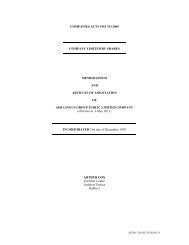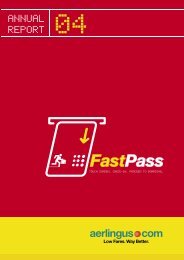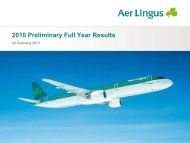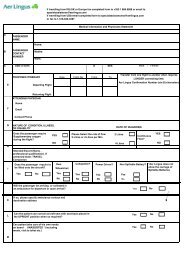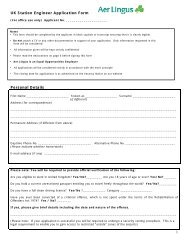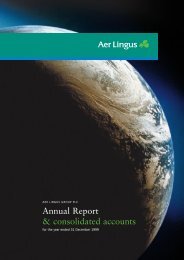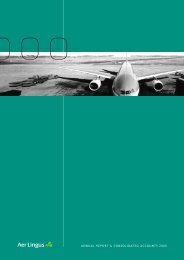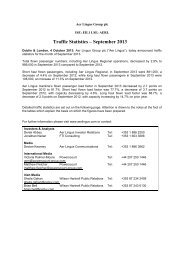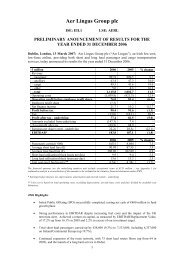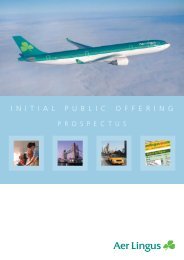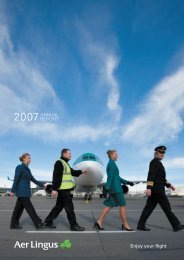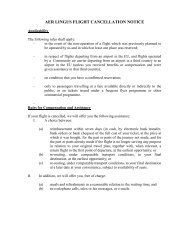annual report 2009 - Aer Lingus
annual report 2009 - Aer Lingus
annual report 2009 - Aer Lingus
Create successful ePaper yourself
Turn your PDF publications into a flip-book with our unique Google optimized e-Paper software.
Financial Statements <strong>Aer</strong> <strong>Lingus</strong> Group Plc – Annual Report <strong>2009</strong>653 Financial risk management [continued](iii) Commodity price riskThe Group’s fuel requirements expose the Group to the market volatility of jet fuel prices. The Group is subject to jet fuel price riskresulting from its operating activities. The volatility of jet fuel prices has been significant in recent years and can have a significant effecton the profitability of operations. The primary policy objective for the management of fuel price exposure in the Group is to reduce thevolatility of fuel costs and increase predictability of future fuel costs.Up to July <strong>2009</strong>, the group treasury function managed the fuel price exposure associated with the Group’s trading activities on aselective hedging basis. This risk management policy targeted a minimum of 40% cover for fuel exposures for the current financial yearand a minimum of 20% for the following financial year. From July <strong>2009</strong>, the Group introduced a systematic fuel hedging policy coveringthe following 2-year period. This systematic hedging policy targets specific cover levels for each of following 24 months on a rolling basis,ranging from 90% cover going into next month to 3% cover 24 months out. This generates average cover levels of approximately 60%for the near 12 month period (rolling year 1) and 20% for the following 12 months (rolling year 2). Under the Policy, the Group canderogate from this systematic hedging requirement, in event of unusual market conditions.The products used by the group treasury function in managing commodity price risk are predominantly commodity swaps.A US $10 increase in the price per tonne of jet fuel price in <strong>2009</strong> would have increased fuel costs by $5.0m(b) Credit riskCredit risk is managed on group basis. Credit risk arises from loans and receivables, derivative financial instruments, deposits andcash and cash equivalents with banks and financial institutions and trade and other receivables. The maximum exposure to credit riskis represented by the carrying amount of each financial asset.Group policy requires financial counterparties to hold minimum credit ratings from independent rating agencies. The appropriatenessand utilisation of Board approved credit limits are regularly monitored and reviewed in light of the commercial requirements of the Group.At 31 December <strong>2009</strong> the Group had a total credit exposure of €0.8bn relating to bonds, deposits and cash, which was spread over27 financial counterparties. Of this €0.7m was due to mature in 12 months. All approved counterparties have minimum short-term creditratings equivalent to P1 (Moody’s). The Group does not have any material credit risk arising from the aging of trade and other receivables.Following the downgrade of many financial institutions’ ratings in <strong>2009</strong>, 8% of the total credit exposure of €0.8bn, was held with financialinstitutions, holding long-term credit ratings equivalent to AAA, AA1 or AA2 (Moody’s). 61% of the total credit exposure was held withfinancial institutions, holding long term-ratings equivalent to AA3/A1. The remaining 31% was held with financial institutions with longtermratings of A2 or A3 (Moody’s), mainly comprising deposits with maturity dates within one year.(c) Liquidity riskThe principal policy objective in relation to liquidity is to ensure that the Group has access at minimum cost, to sufficient liquidity toenable it to meet its obligations as they fall due and to provide adequately for contingencies. In implementing this policy, the Group isrequired to maintain, at all times, access to Board approved minimum requirements. In addition, this liquidity requirement, once drawn,must continue to be accessible for an agreed further period. Cash balances in excess of these levels are normally maintained in order toenable the Group to take advantage of commercial opportunities and withstand business shocks.The Group has long-term debt almost exclusively associated with aircraft acquisitions. All borrowing is undertaken by the group treasuryfunction. Group policy is to maintain, at all times, cash and/or committed facilities for a high proportion of the net forecasted borrowingrequirements for the following 12 months. Where borrowings are made to fund the acquisition of aircraft, policy requires at least 80% ofsuch borrowings must be from facilities that are committed for a period of not less than five years.



